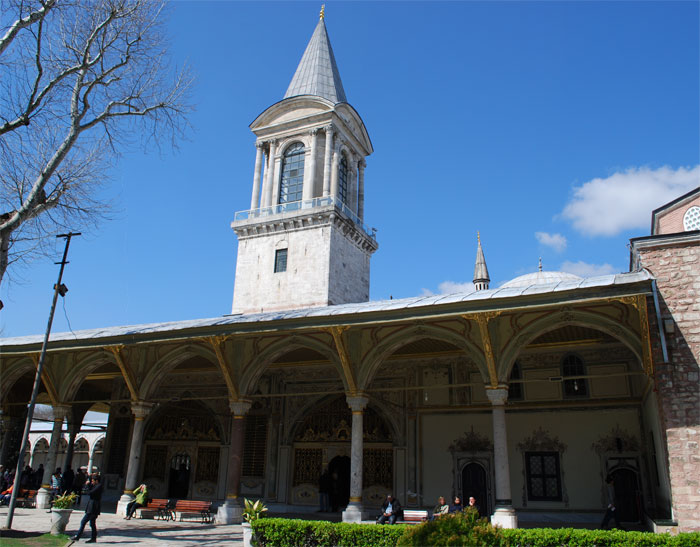A Visit to Istanbul’s Topkapi Palace and Harem
Visiting the Topkapi Palace is like peeling back the layers of an onion. No, wait. It’s more like one of those Russian dolls, with one inside of another getting progressively smaller. Ok, sort of but not really, but you get my point, don’t you?
Most people enter through the Imperial Gate which is located behind and to the right of the Hagia Sofia. You then walk through the walled exterior palace grounds until you reach the ticket booth and along the way pass by the Hagia Eirene and the Archaeological Museum. At the time we went, admission tickets were 25TL per person.

The next layer peels back after passing through the crenelated Gate of Salutations which looks straight out of Disney movie. Be forewarned, you must go through airline style security to get inside (bags are x-rayed).

Once inside there’s a large grassy area and a number of pavilions and buildings. Many of the pavilions have been turned into exhibit rooms showing items from the Sultan’s treasury as well as imperial clothing and the Sultan’s arms and armor (this exhibit was particularly well designed).
While I enjoyed seeing all the bejewled and bedazzled kaftans, scabbards, even a baby’s crib, I was particularly fascinated by the Pavilion of the Holy Mantle which holds many holy relics of Islam and the Prophet Mohammed’s mantle. Twenty four hours a day there are holy men chanting the words of the Koran over the mantle through a microphone. Unfortunately none of these exhibits allowed photographs inside.

After visiting most of the exhibits, we headed for the Harem which requires a separate admission fee of 15TL at the time of our visit. Fortunately, with the price of admission, photographs are allowed inside.

The first thing you will learn when reading about the Harem is that “harem” means “forbidden” in Arabic and that the harem part of the palace was where the sultan’s wives, concubines, children and mother lived, out of sight of prying eyes.





The sheer quantity and variety of tile was absolutely astounding, much of it made with the famous Isnik blue tiles.
Below, the salon of the Valide Sultana, the sultan’s mother (who apparently ruled the roost there, even deciding which of the Sultan’s wives would spend the night with him and when).


The photo at the top of the post shows a detail of the basins set into the windows, shown above. Below, detail of the stained glass windows.

One of the buildings (outside of the harem) which did allow photos was the Library of Ahmet the third. This is a small marble building set in the center of the main courtyard. Like everywhere else in the palace, it’s incredibly ornate.



Lastly, and totally random, we were standing in the middle of the main courtyard in front of the Divan building and these parrots appeared!

Tip: We arrived at the Topkapi palace, shortly after 9am, eager to get a jump on the cruise line/bus tour hoards of tourists. Good thing we did too, because by the time we left, the ticket line was jammed (see below).

For information about visiting and admission prices for the Topkapi Palace, go to the official government web site: http://www.topkapisarayi.gov.tr/


8 Comments
Heather
How lovely, visiting there was one of my favorite days in my Turkish vacation. It was nice to see it again through your eyes.
wired2theworld
Thanks Heather, it was one of my favorite days too!
Jacqueline Church
Gorgeous! I love those tiles. Amazing that the stained glass is so intact, do you know if it has been replaced and repaired over the years? I love the way architecture can seduce you in stages like that. Thank you for sharing! Turkey is on my list for sure.
wired2theworld
Jackie-I love those tiles too. No, I don’t know if the stained glass has been replaced and repaired over the years. I think the palace was lived in well into the 1900’s and then turned into a museum.
Natalie
Aw – Feel like crying. Your pictures of Topkapi are so much better than mine. Still got to do my write up and not sure I want to now 🙁
wired2theworld
Natalie- I appreciate that you like the photos, but don’t say that! Of course you should do your post. I’ve seen your blog and it’s lovely!
Moni
‘Harem’ does not mean forbidden. It’s a place in a Muslim household just for the wives/women.
‘Haraam’ means forbidden. ‘Haram’ is the sanctuary or a sacred place.
wired2theworld
From what I’ve read, both words are derived from the same original word. Perhaps I should have said “derived from” instead of “means” so people don’t take it so literally.